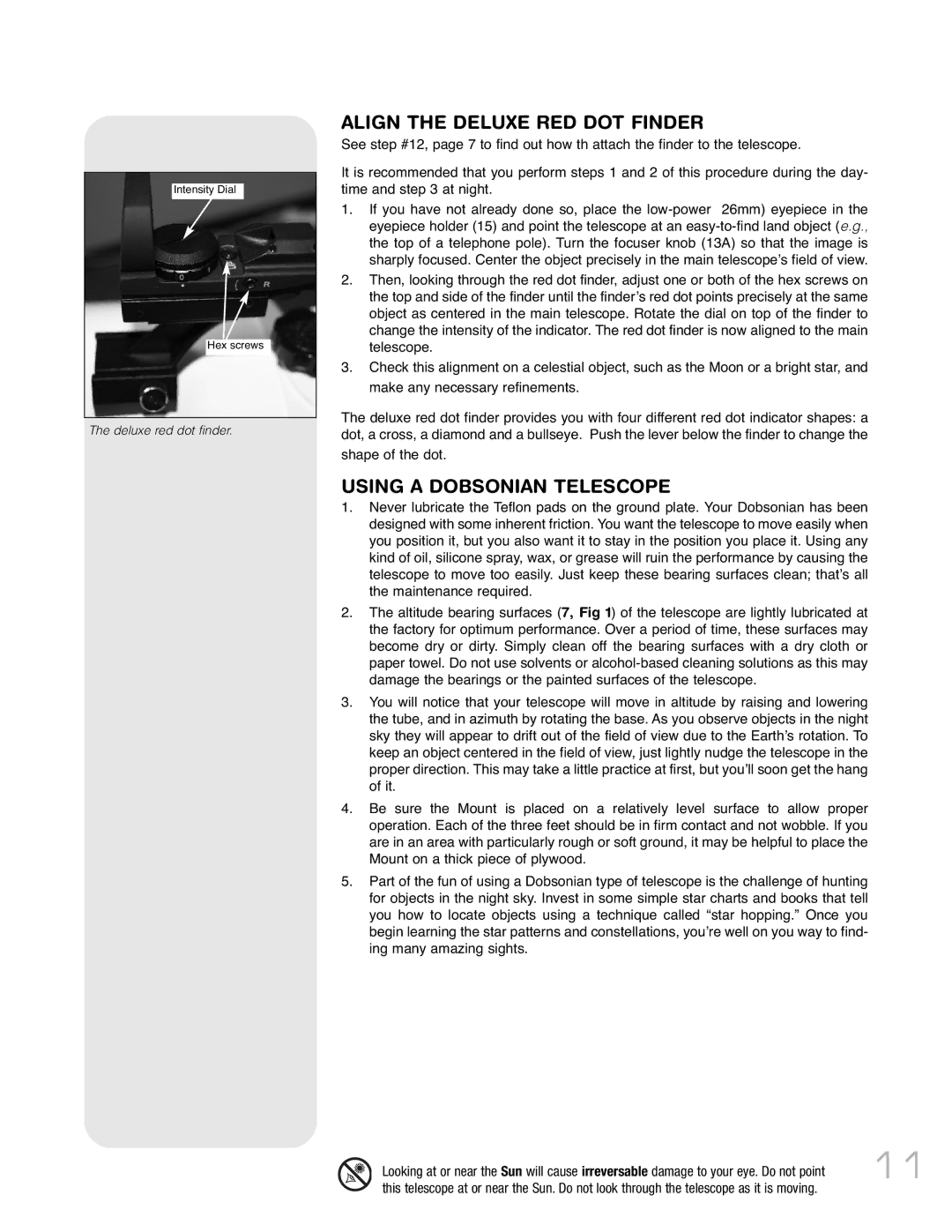
Intensity Dial
Hex screws
The deluxe red dot finder.
SeeALIGNstep #12,THEpageDELUXE7 to find outREDhow thDOTattachFINDERthe finder to the telescope.
It is recommended that you perform steps 1 and 2 of this procedure during the day- time and step 3 at night.
1. If you have not already done so, place the
eyepiece holder (15) and point the telescope at an
the top of a telephone pole). Turn the focuser knob (13A) so that the image.gis., sharply focused. Center the object precisely in the main telescope’s field of view.
2. Then, looking through the red dot finder, adjust one or both of the hex screws on the top and side of the finder until the finder’s red dot points precisely at the same object as centered in the main telescope. Rotate the dial on top of the finder to change the intensity of the indicator. The red dot finder is now aligned to the main telescope.
3. Check this alignment on a celestial object, such as the Moon or a bright star, and make any necessary refinements.
The deluxe red dot finder provides you with four different red dot indicator shapes: a dot, a cross, a diamond and a bullseye. Push the lever below the finder to change the shape of the dot.
1USING. Never AlubricateDOBSONIANthe Teflon padsTELESCOPEon the ground plate. Your Dobsonian has been designed with some inherent friction. You want the telescope to move easily when you position it, but you also want it to stay in the position you place it. Using any kind of oil, silicone spray, wax, or grease will ruin the performance by causing the telescope to move too easily. Just keep these bearing surfaces clean; that’s all the maintenance required.
2. The altitude bearing surfaces ( ) of the telescope are lightly lubricated at the factory for optimum performance7, Fig. Over1 a period of time, these surfaces may become dry or dirty. Simply clean off the bearing surfaces with a dry cloth or paper towel. Do not use solvents or
3. You will notice that your telescope will move in altitude by raising and lowering the tube, and in azimuth by rotating the base. As you observe objects in the night sky they will appear to drift out of the field of view due to the Earth’s rotation. To keep an object centered in the field of view, just lightly nudge the telescope in the proper direction. This may take a little practice at first, but you’ll soon get the hang of it.
4. Be sure the Mount is placed on a relatively level surface to allow proper operation. Each of the three feet should be in firm contact and not wobble. If you are in an area with particularly rough or soft ground, it may be helpful to place the Mount on a thick piece of plywood.
5. Part of the fun of using a Dobsonian type of telescope is the challenge of hunting for objects in the night sky. Invest in some simple star charts and books that tell you how to locate objects using a technique called “star hopping.” Once you begin learning the star patterns and constellations, you’re well on you way to find- ing many amazing sights.
Looking at or near the Sun will cause irreversable damage to your eye. Do not point | 11 |
| |
this telescope at or near the Sun. Do not look through the telescope as it is moving. |
|
